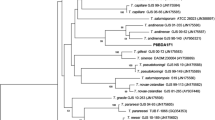Abstract
Rhizocticin A, the main component of the antifungal, hydrophilic phosphono-oligopeptides of Bacillus subtilis ATCC 6633, was used for sensitivity testing and experiments into the molecular mechanism of the antibiotic action. Budding and filamentous fungi as well as the cultivated nematode Caenorhabditis elegans were found to be sensitive, whereas bacteria and the protozoon Paramecium caudatum were insensitive. Rhizoctonia solani was inhibited in agar dilution tests but not in diffusion tests. The antifungal effect of rhizocticin A was neutralized by a variety of amino acids and oligopeptides. Oligopeptide influence was mainly understood as transport antagonism, and it was concluded that the antibiotic enters the recipeint cell via the peptide transport system. l- and d-cystine were also identified as potent, general antagonists of the oligopeptide transport. The rhizocticin-antagonism of four other amino acids was taken as a clue to the site of action. Provided that rhizocticin A is split by peptidases of the target cell into inactive l-arginine and toxic l-2-amino-5-phosphono-3-cis-pentenoic acid (l-APPA), the latter may interfere with the threonine or threonine-related metabolism.
Similar content being viewed by others
Abbreviations
- APPA:
-
(2-amino-5-phosphono-3-cis-pentenoic acid)
- B. :
-
(Bacillus)
- P. :
-
(Paecilomyces)
- S. :
-
(Saccharomyces)
References
Besson F, Peypoux F, Michel G, Delcambe L (1978) Identification of antibiotics of iturin group in various strains of Bacillus subtilis. J Antibiot 31: 284–288
Brenner S (1974) The genetics of Caenorhabditis elegans. Genetics 77: 71–94
Diddens H, Zähner H, Kraas E, Göhring W, Jung G (1976) On the transport of tripeptide antibiotics in bacteria. Eur J Biochem 66: 11–23
Ebata M, Miyazaki K, Takahashi T (1969) Studies on subsporin. 1. Isolation and characterization of subsporins A, B and C. J Antibiot 22: 467–472
Eisele K (1975a) Sequenzvariationen an einem antibiotisch wirksamen Tripeptid. Z Naturforsch 30c: 541–543
Eisele K (1975b) Antibiotisch wirksame Tripeptide der Sequenz l-Arg-d-X-l-Phe. Experientia 31: 764
Gherna R, Nierman W, Pienta P (eds) (1985) Catalogue of bacteria, phages, rDNA vectors, 16th ed. American Type Culture Collection (ATCC), Rockville, MD, USA
Jansen EF, Hirschmann DJ (1944) Subtilin — an antibacterial product of Bacillus subtilis. Culturing conditions and properties. Arch Biochem 4: 297–309
König WA, Loeffler W, Meyer WH, Uhmann R (1973) l-Arginyl-d-allo-threonyl-l-phenylalanin, ein Aminosäure-Antagonist aus Keratinophyton terreum. Chem Ber 106: 816–819
Landy M, Warren GH, Roseman SB, Colio LG (1948) Bacillomycin: an antibiotic from Bacillus subtilis active against pathogenic fungi. Proc Soc Exp Biol Med 67: 539–541
Loeffler W (1970) Ein einfaches Verfahren zum Erkennen von Dermatophyten. In: Götz H, Rieth H, Male O, Turner J (eds) Diagnostik und Therapie der Pilzkrankheiten. Grosse, Berlin, pp 207–234
Loeffler W (1972) Charakterisierung der Dermatophyten auf Grund ihres gruppenspezifischen Verhaltens gegen Antibiotika. Zbl Bakt Hyg 1. Abt Orig A 220: 247–251
Michener HD, Snell N (1949) Two antifungal substances from Bacillus subtilis. Arch Biochem 22: 208–214
Müller E, Loeffler W (1982) Mykologie, 4. Aufl. Thieme, Stuttgart New York
Newton GFF (1949) Antibiotics from a strain of Bacillus subtilis: Bacilipins A and B and bacilysin. Brit J Exp Pathol 30: 306–319
Nisbet TM, Payne JW (1979a) Specificity of peptide uptake in Saccharomyces cerevisiae and isolation of a bacilysin-resistant transport deficient mutant. FEMS Lett 7: 193–196
Nisbet TM, Payne JW (1979b) Peptide uptake in Saccharomyces cerevisiae. Characteristics of a transport system shared by dipeptides and oligopeptides. J Gen Microbiol 115: 127–133
Peypoux F, Pommier MT, Marion D, Ptak M, Das BC, Michel G (1986) Revised structure of mycosubtilin, a peptidolipid antibiotic from Bacillus subtilis. J Antibiot 31: 284–288
Rapp C, Jung G, Katzer W, Loeffler W (1988a) Chlorotetain aus Bacillus subtilis, ein antifungisches Dipeptid mit einer ungewöhnlichen chlorhaltigen Aminosäure. Angew Chem 100: 1801–1802. Chlorotetain from Bacillus subtilis, an antifungal dipeptide with an unusual chlorine-containing amino acid. Angew Chem Internat Ed in Engl 27: 1733–1734
Rapp C, Jung G, Kugler M, Loeffler W (1988b) Rhizocticins —new phosphono-oligopeptides with antifungal activity. Liebigs Ann Chem 1988: 655–661
Walker JE, Abraham EP (1970) The structure of bacilysin and other products of Bacillus subtilis. Biochem J 118: 563–565
Zähner H, Maas WK (1972) Biology of antibiotics. Springer, New York
Author information
Authors and Affiliations
Additional information
Dedicated to Professor Dr. Hans Zähner for the 60th return of his birthday
This work was supported by the Deutsche Forschungsgemeinschaft (DFG-Lo 3201, SFB 3232)
Rights and permissions
About this article
Cite this article
Kugler, M., Loeffler, W., Rapp, C. et al. Rhizocticin A, an antifungal phosphono-oligopeptide of Bacillus subtilis ATCC 6633: biological properties. Arch. Microbiol. 153, 276–281 (1990). https://doi.org/10.1007/BF00249082
Received:
Accepted:
Issue Date:
DOI: https://doi.org/10.1007/BF00249082




